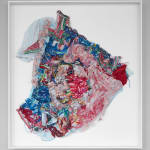 Gumandafa (Never)
Gumandafa (Never)
 Gumandafa (Never)
Gumandafa (Never)
Georgina Maxim
35 43/100 x 23 31/50 in
Georgina Maxim was born in 1980, and works and lives in Harare, Zimbabwe. For the past two decades, textiles, particularly pieces of clothes, have been a consistent feature in Maxim’s practice. Maxim is a graduate
of Chinhoyi University (2002) where she briefly explored painting amongst other mediums. Though she was surrounded by painters early on in her career, she did not cave into the peer pressure, nor was lured by the popularization of the medium at that time. Instead, she found that textile offered her a more grounded lexicon to better communicate her concerns. Maxim states: “Clothing was immediately available with the inherited garments of my grandmother. Preserving her clothes became more important than discarding them. I also wanted to defy tradition by creating a new way of preserving her memory. Clothes may tell many stories: the moment of ownership, or even sometimes when we start hating them. The stories of these clothes are endless; therefore, textile became the obvious choice to me.”
The preservation and restoration of memory are at the heart of Georgina Maxim’s work. Weaving and embroidering, she assembles hundreds of fabrics, culled from shirts, dresses, and other secondhand feminine clothes. These garments evoke histories, suggesting testimonies of the people who wore them in the past. Georgina Maxim shreds these textiles and then sews the tatters together again stitch by stitch, multiplying the stories they encode and inventing new ones. The textile medium gives the works organic immediacy. The artist addresses the bodies that have inhabited these clothes – as well as their absence.
For the artist, the use of inherited clothes references the local practice of kugova nhumbi, which is a way of ensuring
that though a person has passed away, their essence remains amongst their people. Once a loved one dies, close family members gather in order to distribute amongst themselves
the deceased’s belongings, mainly clothes. However, for many in today’s predominantly Christian Zimbabwe less spiritual emphasis is placed on this ritual. The distributed clothes are merely precious mementos or wearable memorials. For Maxim, though she started off by using her own grandmother’s inherited clothes, she has since used her own clothes as well as those of other relations. In most cases, where pre-owned fabrics have been used, she would have had some form of relationship with the wearer.
In her artist statement, Maxim declares, “ndazvigovera nhumbi” which means that she has distributed her own belongings to herself even though she is alive. The used fragments of cloth come from her own wardrobe, she writes: “The woman I search for, many have regarded her as a memory. For me it’s a place - that place of searching for this person will become a memory. May she follow me from the front and may she go slow as is evident with my work. May she send answers to what was done to bring me here. May she be the scribe on my soul. May she not look like the sun but the memory of the sun.” Maxim thus creates singular works that escape definition: the artist herself describes her work as an act of memory, a transcription of the moment, the lived moments and stories evoked by these used textiles. The title of the present work, “Gumandafa”, is the Shona word for ‘never’ and according to Maxim is short for “I will never be the woman you want me to be” in a message of female empowerment.

